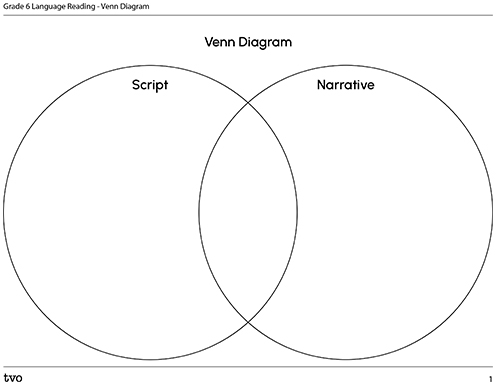Minds On
Act III, scene I
Examine the following excerpt. You can read the excerpt or, if you prefer, access an audio version.
What do you notice? What type of text is this? How do you know?

“Text Excerpt”
Action
Part 1: Let’s play!

What reads like a story, but is not a narrative?
In the Minds On section, you explored a script excerpt from Lewis Carroll’s play, “Alice in Wonderful: In Five Acts.” In this case, the script is for a play.
Much like a narrative, a play also has a storyline with a plot, characters, and setting. However, there are key differences between the two types of texts. For starters, one story takes place on a page, and the other, on a stage.
The other notable differences are the dialogue and the length.
The dialogue
In a play script, dialogue appears next to or under a character’s name. The actor’s line (what they read aloud) also includes a parenthetical, which is a mini direction for the actor speaking the part. The following is an example of dialogue from “Alice in Wonderland: In Five Acts” by Lewis Carroll.
The parenthetical, (gazing at the sky), tells the actor who’s playing the Frog Footman to look up as they speak (Carroll, 2018). Please note, the parenthetical is not read aloud.
In a narrative, the dialogue is enclosed in quotation marks. For example,
“What time is it?” Andrea asked.
The length
Scripts are typically shorter than narratives. This is because scripts and plays convey meaning through a combination of words and images. Narratives on the other hand, rely solely on words and descriptions, and as a result, are longer in length. (Sometimes several hundreds of pages long!)
Let’s explore the elements of a play by examining a script more closely.
Student Tips
Take some time

Please note, the Action section has three parts in total. Take the time you need to work through each section and to grasp the information.
Part 2: Elements of a script
Take a moment to examine the following script excerpt from Nancy Wallace’s play, Pickles and Parks.
The following elements have been marked on the pages: act and/or scene heading, name of character, dialogue, and parentheticals. Let’s discuss the purpose of these elements.
Act and/or scene heading
Similar to chapters in a narrative, an act and/or scene heading helps to organize a script. The act and/or scene heading tells us where we are in the script and can also include a short description that explains where the scene takes place.
It’s important to note that not all scripts will have an act and a scene heading. For example, the following sample from Pickles and Parks doesn’t have an act indicated, but we know the excerpt is from Scene 4: Earth Day (Wallace, 2015).
The description under the scene heading also provides us with information that helps to set the scene including props and directions for background actors, or “extras.”
What is an act?
Acts: Much like a narrative, plays are also stories and have a beginning, middle, and end. This is why some plays also have three acts.
Names of characters
The script clearly indicates the character speaking and any actions they take (e.g., facial expression, body language, and gestures). It’s this information that helps the actor bring the character to life for the audience.
The following excerpt shows that the dialogue takes place between three characters, Mrs. Morena, Ella, and Grace. (A dialogue is a conversation that takes place between two or more characters.)
Parentheticals ()
In the script, stage directions are provided (in parentheses). The text inside the parentheses or, parentheticals, tells the actor how to speak a line, but they can also give an actor some kind of action to do while they speak the line.
For example, examine the following excerpt from Pickles and Parks. The line (She holds out a basket with seed packets stapled to recipe cards.) tells us that Ella is holding a basket with seed packets stapled to recipe cards (Wallace, 2015). She will hold out the basket before she speaks the line, “I’ve given out almost 200 pickle recipes” (Wallace, 2015).
Find all of the stage directions
Examine the following script excerpt from Pickles and Parks more closely. Find all the stage directions. You can type, write, use speech to text or audio record your findings.
What helped you to identify the stage direction? What information do the stage directions provide the actor with?
Part 3: Compare and contrast

Compare and contrast the following excerpts. You will compare and contrast a scene from a book to the same scene in a play.
The first excerpt is from Lewis Carroll’s play, “Alice in Wonderland: In Five Acts” (Carroll, 2018, p. 29).
The second excerpt is from Lewis Carroll’s book, “Alice’s Adventures in Wonderland & Through the Looking-Glass” (Carroll, 2000, p. 59).
You can use the following fillable and printable Venn Diagram template to compare and contrast the texts. You can also complete this activity in your notebook or use another method of your choice. (You can also look ahead to your reflection questions in the Consolidation section and use them to guide your comparison.)
Consolidation
I used to think… but now I think
Use your completed Venn diagram and the questions below to reflect on your learning.
- How is this script similar to the narrative? How is it different?
- Which excerpt provides the reader with a more complete description of what is happening in the story? Explain you thinking.
- When it comes to description, what are the advantages and/or disadvantages of scripts and narratives?
- How do the different script elements help you to understand the text better?

Record your responses using a method of your choice.
Reflection
As you read through these descriptions, which sentence best describes how you are feeling about your understanding of this learning activity? Press the button that is beside this sentence.
I feel...
Now, record your ideas using a voice recorder, speech-to-text, or writing tool.
